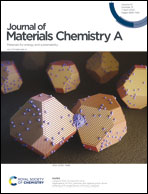Interfacial engineering for metal oxide/nitride nano-heterojunctions towards high-rate lithium-ion storage†
Abstract
To satisfy the requirements for high-power energy storage devices, high-rate anode materials are highly desirable. Herein, precise interfacial engineering of transition metal oxides (TMOs: α-Fe2O3, T-Nb2O5, WO3) is achieved to construct TMO/TMN nano-heterojunctions. The interfacial interaction and synergistic effects of the building blocks endow the integrated nano-heterojunctions with enhanced lithium-ion (Li+) storage performance. Density functional theory (DFT) calculations of Fe3O4/Fe2N reveal that the electrons flow from Fe2N to Fe3O4 through the strong coupling heterointerfaces and a built-in electric field (BIEF) is induced. Such a BIEF can push Li+ ions into the negatively charged Fe3O4, which is responsible for the high Li+ adsorbability (−1.974 eV) and low diffusion barrier (0.63 eV), thus promoting the electron/ion transfer kinetics and further enhancing the rate capability (712.3 mA h g−1 at 0.1 A g−1 with a retention of 75% at 2.5 A g−1). Moreover, the secondary-structure of the nano-heterojunctions can retain their structural integrity during the charge–discharge processes, resulting in a long-term cycling stability. This work offers an instructive concept on promoting the electron/charge transfer kinetics via interfacial engineering to boost high-rate Li+ storage.



 Please wait while we load your content...
Please wait while we load your content...